Sound & Vision
Bristol, February 22-24, 2004
Part I
Author: Werner Ogiers

|
|
|
[RECYCLE] This year's Bristol show was a rather quiet affair, with not too many significant product launches. Maybe the reviving London Heathrow show has to do with it. But who am I to complain? The wheather was brilliant, we had four days of solid fun, and yes, there were new turntables launched at the show. [/RECYCLE] What an intro, not? Before you scream that I'm overpaid, please consider that I'm not. Paid at all, that is. In fact, I invested in a digital camera for this trip, so TNT's balance is firmly negative now. Oh yes, my company makes the CMOS sensor for the Kodak DSLRs, but imagine how much fun it is to schlepp a DCS14 and its harem of lenses from show room to show room with only Ken Kessler sympathising with you, if at all. Anyway, a new camera means lots of pictures (click on the thumbnails to reveal the whole picture), and so I've split the show report in two parts. You'll have to be a bit patient for some of the bits. Bits indeed: the three buzzwords of this year's exposition were Wireless, DAB, and Networking. Audio is changing. And yet, turntables were, once more, dominantly present. Or is that just in the eye of this particular beholder? |
|
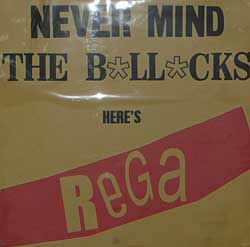 | |
|
Those scoundrels at Rega ... Coming from a past when they considered themselves well above hifi shows, they now attend, and even launch product at them. This year saw a new tonearm, two new turntables, and a flagship loudspeaker. |
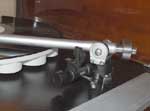 |
|
The RB700 replaces the short-lived RB600 arm. It is, of course, essentially the same, except for a new leadout cable, and an RB1000-style arm base and finger lift, although executed in plastic rather than steel. If you have one of those after-market VTA-raisers, then forget about it as now Rega's two upper arms use the 3-point mounting system introduced with the RB900. |
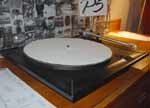 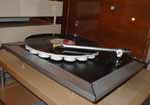 |
|
Anyway, the RB700 is put onto two new turntables: the UKP 700 P5 is the replacement for the anniversary (and cute) P25. In fact, apart from cosmetics there is not much difference. Really new is the P7 then (UKP 1300), a cross between P5 and P9 technology. The P7 has a ceramic platter, but rather than the P9's expensive custom job, this one is seemingly built from off-the-shelf ceramic parts, viz. one 30 cm disc, weighted at its periphery, Michell/Transrotor-style, with 17 smaller ceramic pucks. The motor is driven from an outside power supply that is only marginally less evolved than the P9's. Both turntables sport a new-style trim, foregoing the rather pretty Habitat-like wooden surrounds of yore. I certainly don't like the looks of them, although amusingly the P7 reminds me of the direct-drive JBE of the late seventies. The R9 then: now you know what Roy Gandi's been doing in the past years. Very un-Rega this speaker is big, complex, and rather expensive at its 2500 UKP (although compared to recent pricing fashion not expensive at all, of course). A four-way with dome midrange and tweeter, this big one has side-firing woofers. |
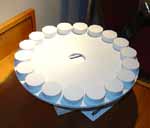 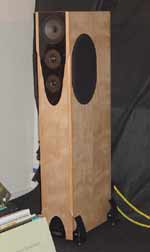 |
|
| |
|
Michell Engineering had, for the first time at a public show, their latest tonearm, the TecnoArm(a). Superficially resembling the now-discontinued TecnoArm that was launched in 2003, the (a)-suffixed version is one of the most massive attempts at modifying a Rega RB-250 in existence: the arm wand is bead-blasted and drilled for lightness and resonance dispersion. Damping foam is added, and the underside of the headshell is machined true with reference to the horizontal bearing, for correct azimuth. After this the arm is reassembled and the bearings are finely adjusted according to standing Rega-procedures. | 
|
| The wiring is all new, starting with custom machined-from-solid (!) silver-plated cartridge clips, through a continuous run of thin-stranded pure silver wire in teflon dielectric, and on to silver-plated RCA plugs of some substance. An independent earth drain wire is present. | 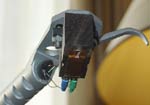
|
| The far-end of the arm has the TecnoWeight counterweight, which includes a precision VTF-adjuster, and further, the arm is sold complete with a VTA-adjustment collar and a handy finger locknut that gives easy access for assembly or height adjustment jobs. The price? A ludicrously low UKP400! | 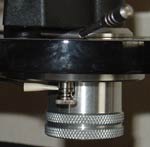
|
| Other news was a new version of the Orbe Controller, now incorporating the Never-Connected active rectification power supply circuit. Also on demo was a new Trichord multi-channel DVDA/SACD player, the Fusion, essentially a modified Pioneer DV-563. | 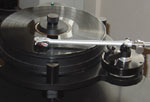
|
|
| |
|
ProAc kept things modest this time, demonstrating the new Response D38 and D25, the latter a clear successor to the Response 2.5, which must be the most-cloned high-end loudspeaker, with reverse-engineered building instructions all over the internet. Sad that ProAc did not bring their D100 top-of-the-range. I heard the (finished) prototype of this monster speaker last year, and believe me, that one must be one of the very best around, bar none. Townshend came, complete with a Teutonic looking system comprising of the Ode-to-Joy Rock turntable with the front-damped Excalibur MkIII arm, TA565 universal DVD-A/SACD player, TAP-1 preamplifier and TAA-1 stereo digital power amp, Seismic Sink Stand and matching matched cables, and last of course the big Glastonbury III loudspeakers with ribbons and with 100kHz supertweeters. The whole a snip at 30000 UKP! | 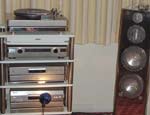 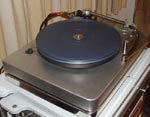 |
|
| |
| 25 years of Clearaudio is celebrated with the Anniversary turntable, here seem with their own Unify arm and a Graham. The mark also launched a new top-of-the-line phonopreamp, the Balance Reference. This dual-mono phonostage incorporates a volume control for those wanting to run a minimalist system. | 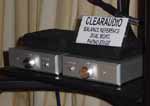 |
| Another phonostage hailed from newcomer Whest Audio, the ps.20, boasting a "unique Neumann cutter head compensation": my DIY designs had this already ten years ago. More juicy stuff can be found in the blurb for their dap.10/dap.20 "discrete analog processors", seemingly magic boxes that "fully realise your system's potential regardless of cost" because "All audio sources exhibit above 35Khz (sic) what we call audio ghosting ... Between 0Hz and 34.99Khz the dap units have no effect ... Above 35Khz what happens is something short of a marvel. After proprietary signal processing in the region from 35Khz to 120Khz, the ghost images are aligned with the main signal ..." Brilliant, not? Now where's my credit card ... |  |
| Absolutely new to me were the electronics from Italian manufacturer Audia. Big, impressive, Krellinson-style. A range of pre and power amplifiers, all using transimpedance stages and current feedback, with the output stages operated open-loop. The Flight Pre has three power transformers and user-configurably input naming. | 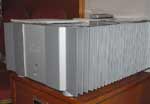 |
|
The other Italians at the show, Audio Analogue of course, brought a new series of small-width electronics, Aria, all costing UKP500 and including a CD-player, an integrated amplifier, and a phonostage.
AA's expected Inciso turntable was nowhere to be seen, even though a hastily-produced product folder was found. As far as I could see it is going to be big and massive. It will sport modified Rega arms, and a, erm, graphite carpet, Dude. | 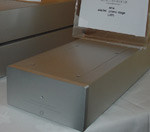 |
|
| |
| Before I forget, there was another 25th anniversary: that of German T+A. A name I admired since their huge marble-made transmissionline speakers with ribbon tweeters and on-board OTL valve amps for said tweeters. From speaker builder they evolved into a much more ambitious company, with their outspoken designs carrying on themes earlier established by the likes of Braun and very early B&O. |
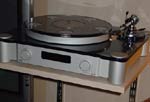 |
|
The party starts with a style-breach, though. The weird V10 valve amp is probably know to most of you. Perhaps less so the matchng G10 turntable, looking like a modern integrated amplifier with a platter on top. Part of the G10's claim to fame stems from it being the first platform that carried SME's new M2 tonearm, a tonearm quickly snatched up by Musical Fidelity for their M1 table. Oh well. As said, the G10 comes complete with tonearm, and with cartridge: T+A now market two moving coil models, C-10 and C-5, made for them by Benz Micro. Vive la fete! |
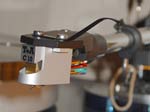 |
|
| |
|
A bit more high-tech now, even digital. From dCS there was a red-coloured transport and DAC combo (picture included just for the looks and for those who thought only battleship colour schemes were in).
Fujitsu/Eclipse complemented their existig desktop monitor 'eggs' with the Lulet 300-series of small speakers, active sub, and dedicated integrated amplifierlets. | 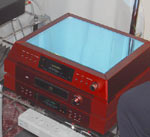 |
|
| |
|
Lexicon demoed the UKP9000 MC12 AV preamp/processor, with their own DVD player and CX poweramps, using the new 'lower-cost' F32/C32 range of Revel loudspeakers and Pink Floyd-sourced software. It must be said, the results were rather good. Very good, even.
Likewise, studio monitor and transmission line specialists PMC went multi too, with the CB6 center speaker, a big three-way with a dome midrange driver, and matching the OB1 column speaker launched last year. | 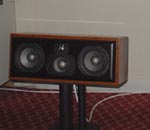 |
|
| |
|
Back to business. Living Voice had brought together a system of near-legendary status: Kondo Gakuoh valve amps, SME 30 turntable/arm, and one of those big and fat Audio Note cartridges.
Epos expanded their range of M speakes to five models, catering for AV too, and with greatly enhanced looks thanks to a veneered front panel. |  |
|
| |
| One of the best sounds of the show could be heard in Seventh Veil's room, through the energetic demoes of a very very very enthousiastic Steve Margolis. His Nonsuch 4 loudspeakers are tall columns made up of tens of ellips-shaped sections of wood glued together, giving an irregular inner volume, into which work four 2.5" wideband Bandor units in tandem. If desired, and it is, the Little Awesome passive subwoofers can be added to the mix, including the ABE valve bass equalizer. The result is a full-bodied, quite dynamic sound, warm, inviting, natural, ... all you wish. Except a lack of treble, only really heard on some types of music. Perhaps SV could consider blending in an optional ribbon tweeter to increase the marketing appeal of these fascinatig speakers? | 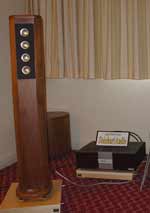 |
|
| |
| Now a bunch of turntables in no particular order. Relatively new is the Roksan TMS2, which is smaller than expected in real life. You knew already that this one costs a cool UKP 10000. Also on display the wooden version of the Radius 5. I took a picture because all images published so far were of the more expensive acrylic-made variant. Pro-Ject had an upper-class version of their established RPM9: the RPM9X, with a thick acrylic plinth and costing UKP 200 more. Another thick one was the VPI Scout Master, complete with JMW-9 arm. | |
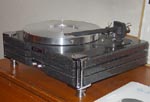
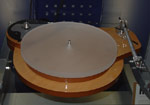

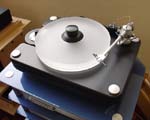
| |
|
| |
|
REL are revamping their subwoofer line. Beginning down below, the new Stampede is a 40 cm high model with an 8" woofer, 100W power amp, and blue-LED front-mounted display. The Strata 5 is similar, if some 70% bigger Gone are the days of unvoluntary kneefalls in front of the system during setup, as the new RELs are entirely remote-controlled!
Naim brought a new medium-format floorstanding speaker. I foolishly forgot the name of the thing, but it is a three-way of cute proportions which, remarkably, employs the Vifa/Scanspeak ring tweeter so beloved of the mainstream high-end speaker scene. | 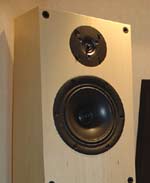 |
|
Contrary to earlier shows, Naim dropped their unsympathetic practice of closed-door ticket-only demonestrations of their top gear, now confining themselves to normal hotel rooms, just like almost anybody else. I found their sound generally still to abrasive, but the company is a-changing. By the way, there are now add-on aluminium front plates for the central section of the 5-series housing available.
Anyway, the more important news could be found in a small, blacked-out room at the ground floor, almost lost amidst the show events around. | 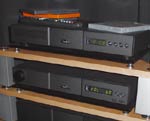 |
| In that room stood a series-5 system, augmented with the AV2 AV-processor and ... Naim's brand new DVD5 DVD-Audio player. The DVD5s at the show were still incomplete in that they output only stereo analogue audio (on RCA plugs), but pretty soon the production versions should get DIN connectors and multi-channel output too. Anyhow, the machine is geared towards quality video and interconnectivitibility, with gold-plated BNC connectors and a DVI/HDMI digital protected contents interface. Cost is around UKP 2300, which is, given the lack of SACD, a bit stiff if you ask me. |  |
| But anyway, blasting through the company's NBL loudspeakers at the front, Allae or whatever at the back, an M&K sub in below, and Peter Gabriel's Growing Up concert DVD on repeat (Gabriel lives in the nearby village of Box), this room was packed with serious fun. In fact, I spent a couple of hours in there, in snatches of 3 songs each time. To rest from the show chores (like writing this report), and to get the Gabriel disc viewed in its entirity. The sound was dynamic, exciting, and even if somewhat fierce, entirely suited to the replay of an energetic live set. | 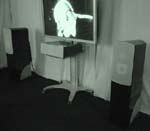 |
|
| |
| So far for part 1. [Click here for Part II] | |
© Copyright 2004 Werner Ogiers - www.tnt-audio.com